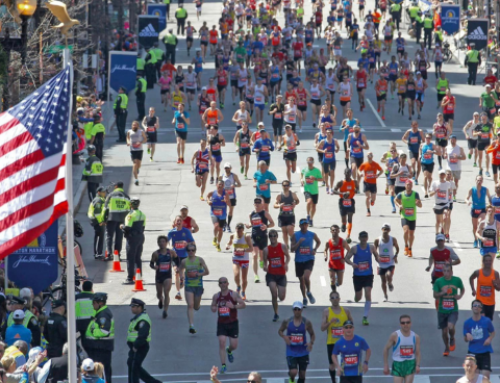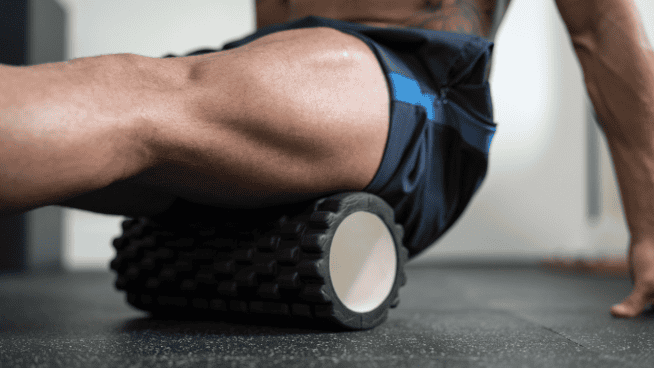Air Bike Training: A Necessity for Aerobic Performance
The Assault Bike or Air Bike has garnered considerable popularity among athletes as a conditioning tool that drives athletic performance. Although its primary use is for anaerobic conditioning, coaches would do well to recognize this training modality for its aerobic benefits, too.
Contrary to other cardio tools, the Air Bike is unique because it can match the athlete’s intensity. That is, athletes’ will have to battle the wind resistance provided via the large bike fan. What’s more, the bike handles move with the pedaling action so the user can reap the additional benefits of full-body training. The beauty of the Air Bike lies in its simplicity. Strength coaches can have their athletes use it for a warm-up, post-session cool-down, and as a sure-fire way to meet the energy system demands of their given sport.
Top Benefits:
- Low Impact – Originally, Air bikes were promoted to the elderly population as a safe, injury mitigating training tool. Therefore this is one of the most effective options for rehabilitation or simply limiting the milage on your joints.
- Total-Body Conditioning – Air bikes provide a full-body training effect that bars none. The provided stimulus will improve heart health and muscle tissue capacity.
- Recovery – Bike training will enhance blood circulation to assist in the recycling of nutrients throughout the body. Active recovery methods may enable additional clearance of blood lactate, previously accumulated during high-intensity exercise.
- Versatility – Athletes can reap the fat loss benefits with a quick, Tabata-Esque workout or perform a long-duration procedure. Air bikes can accommodate any training method to achieve your chosen goal. Not to mention it has a small footprint – desirable for any strength coach looking to maximize their gym space.
Aerobic System Training Methods
Cardiac Output Method –
What is the significance?
This method will improve oxygen supply by increasing the effectiveness of oxygen delivery from the heart. It can further develop the peripheral vascular network.
How does it improve performance?
Cardiac output training works by promoting eccentric cardiac hypertrophy. The volume overload of cardiac fibers leads to increased left ventricular cavity volume.
Guidelines
To use the cardiac output method, you’ll have to train with a constant heart rate between 130-150 bpm for a reasonable duration.
Instructions
- Heart Rate (HR) between 130-150 bpm
- Session length between 30-90 minutes
- 1-3 sessions per week
Cardiac Power Intervals –
What is the significance?
This method helps improve oxygen supply at higher intensities and bolster the power endurance of the cardiac muscle.
How does it improve performance?
Power intervals support an increase in contractile strength of the cardiac fibers. There will then be a corresponding increase in mitochondria.
Guidelines
To benefit from cardiac power intervals, you’ll need to do maximum intensity intervals of 60-120 seconds with a long duration recovery of 2-5 minutes. Consider using between a 1:2 and 1:5 work-to-rest ratio. Start with less volume to build work capacity in the weeks following.
Instructions
- Maximal HR each rep
- 2-5 minute rest of HR between 120-130 bpm
- 4-12 reps per session
- 1-2 sessions per week
Threshold Training –
What is the significance?
Threshold training increases the aerobic system’s maximum rate of ATP regeneration. Also, it will further strengthen aerobic power output.
How does it improve performance?
This training method will raise the anaerobic threshold and peak power at said threshold. In turn, this will delay the point at which the anaerobic processes begin to take over.
Guidelines
The premise of the threshold training method is to work your aerobic system to the maximum limits of its energy production abilities. The body will adapt by increasing the total number of aerobic enzymes.
Before starting this method, you’ll need to estimate your anaerobic threshold. Start with a simple 3×5 minute test, using sparring or something comparable like a modified coopers test. Once you have found your average heart rate over the three rounds, you can utilize this training method to the fullest.
Instructions
- HR +/- 5bpm of anaerobic threshold
- Keep HR within range for the entire set
- 3-10 minutes per rep
- 2-5 reps per workout, 1-2 x per week
Sample 3-Day Training Week
Day 1 – Cardiac Output Method
Steady State:
30-minute Ride (HR between 130-150 bpm)
Note: This is a casual pace. You should be able to maintain a conversation with relative ease.
Day 2 – Cardiac Power Intervals
Sprints:
20 seconds on/ 40 seconds off x 8-10 rounds
Note: You should be working at maximum capacity for each repetition. Rest 2-5 minutes (HR <130) before performing another set.
Day 3 – Threshold Training
Short “Aerobic” Power Intervals:
Bike at Anaerobic Threshold for 3-rounds of 5 minutes. 2-minute rest between rounds.
Closing Thoughts
Air bike training is one of the most efficient options to improve your aerobic performance. They are user-friendly and have a minimal footprint compared to other training modalities. Furthermore, air bikes have a myriad of programming options to support any athletic endeavor, be it endurance, power, or density workouts. Keep in mind that regardless of the sport, aerobic training is a worthy undertaking to improve heart strength and capacity, stamina, and further recovery efforts.
References
Jamison, Joel. Ultimate MMA Conditioning. Performance Sports Inc, 2009.
RECOMMENDED FOR YOU
Air Bike Training: A Necessity for Aerobic Performance
The Assault Bike or Air Bike has garnered considerable popularity among athletes as a conditioning tool that drives athletic performance. Although its primary use is for anaerobic conditioning, coaches would do well to recognize this training modality for its aerobic benefits, too.
Contrary to other cardio tools, the Air Bike is unique because it can match the athlete’s intensity. That is, athletes’ will have to battle the wind resistance provided via the large bike fan. What’s more, the bike handles move with the pedaling action so the user can reap the additional benefits of full-body training. The beauty of the Air Bike lies in its simplicity. Strength coaches can have their athletes use it for a warm-up, post-session cool-down, and as a sure-fire way to meet the energy system demands of their given sport.
Top Benefits:
- Low Impact – Originally, Air bikes were promoted to the elderly population as a safe, injury mitigating training tool. Therefore this is one of the most effective options for rehabilitation or simply limiting the milage on your joints.
- Total-Body Conditioning – Air bikes provide a full-body training effect that bars none. The provided stimulus will improve heart health and muscle tissue capacity.
- Recovery – Bike training will enhance blood circulation to assist in the recycling of nutrients throughout the body. Active recovery methods may enable additional clearance of blood lactate, previously accumulated during high-intensity exercise.
- Versatility – Athletes can reap the fat loss benefits with a quick, Tabata-Esque workout or perform a long-duration procedure. Air bikes can accommodate any training method to achieve your chosen goal. Not to mention it has a small footprint – desirable for any strength coach looking to maximize their gym space.
Aerobic System Training Methods
Cardiac Output Method –
What is the significance?
This method will improve oxygen supply by increasing the effectiveness of oxygen delivery from the heart. It can further develop the peripheral vascular network.
How does it improve performance?
Cardiac output training works by promoting eccentric cardiac hypertrophy. The volume overload of cardiac fibers leads to increased left ventricular cavity volume.
Guidelines
To use the cardiac output method, you’ll have to train with a constant heart rate between 130-150 bpm for a reasonable duration.
Instructions
- Heart Rate (HR) between 130-150 bpm
- Session length between 30-90 minutes
- 1-3 sessions per week
Cardiac Power Intervals –
What is the significance?
This method helps improve oxygen supply at higher intensities and bolster the power endurance of the cardiac muscle.
How does it improve performance?
Power intervals support an increase in contractile strength of the cardiac fibers. There will then be a corresponding increase in mitochondria.
Guidelines
To benefit from cardiac power intervals, you’ll need to do maximum intensity intervals of 60-120 seconds with a long duration recovery of 2-5 minutes. Consider using between a 1:2 and 1:5 work-to-rest ratio. Start with less volume to build work capacity in the weeks following.
Instructions
- Maximal HR each rep
- 2-5 minute rest of HR between 120-130 bpm
- 4-12 reps per session
- 1-2 sessions per week
Threshold Training –
What is the significance?
Threshold training increases the aerobic system’s maximum rate of ATP regeneration. Also, it will further strengthen aerobic power output.
How does it improve performance?
This training method will raise the anaerobic threshold and peak power at said threshold. In turn, this will delay the point at which the anaerobic processes begin to take over.
Guidelines
The premise of the threshold training method is to work your aerobic system to the maximum limits of its energy production abilities. The body will adapt by increasing the total number of aerobic enzymes.
Before starting this method, you’ll need to estimate your anaerobic threshold. Start with a simple 3×5 minute test, using sparring or something comparable like a modified coopers test. Once you have found your average heart rate over the three rounds, you can utilize this training method to the fullest.
Instructions
- HR +/- 5bpm of anaerobic threshold
- Keep HR within range for the entire set
- 3-10 minutes per rep
- 2-5 reps per workout, 1-2 x per week
Sample 3-Day Training Week
Day 1 – Cardiac Output Method
Steady State:
30-minute Ride (HR between 130-150 bpm)
Note: This is a casual pace. You should be able to maintain a conversation with relative ease.
Day 2 – Cardiac Power Intervals
Sprints:
20 seconds on/ 40 seconds off x 8-10 rounds
Note: You should be working at maximum capacity for each repetition. Rest 2-5 minutes (HR <130) before performing another set.
Day 3 – Threshold Training
Short “Aerobic” Power Intervals:
Bike at Anaerobic Threshold for 3-rounds of 5 minutes. 2-minute rest between rounds.
Closing Thoughts
Air bike training is one of the most efficient options to improve your aerobic performance. They are user-friendly and have a minimal footprint compared to other training modalities. Furthermore, air bikes have a myriad of programming options to support any athletic endeavor, be it endurance, power, or density workouts. Keep in mind that regardless of the sport, aerobic training is a worthy undertaking to improve heart strength and capacity, stamina, and further recovery efforts.
References
Jamison, Joel. Ultimate MMA Conditioning. Performance Sports Inc, 2009.










